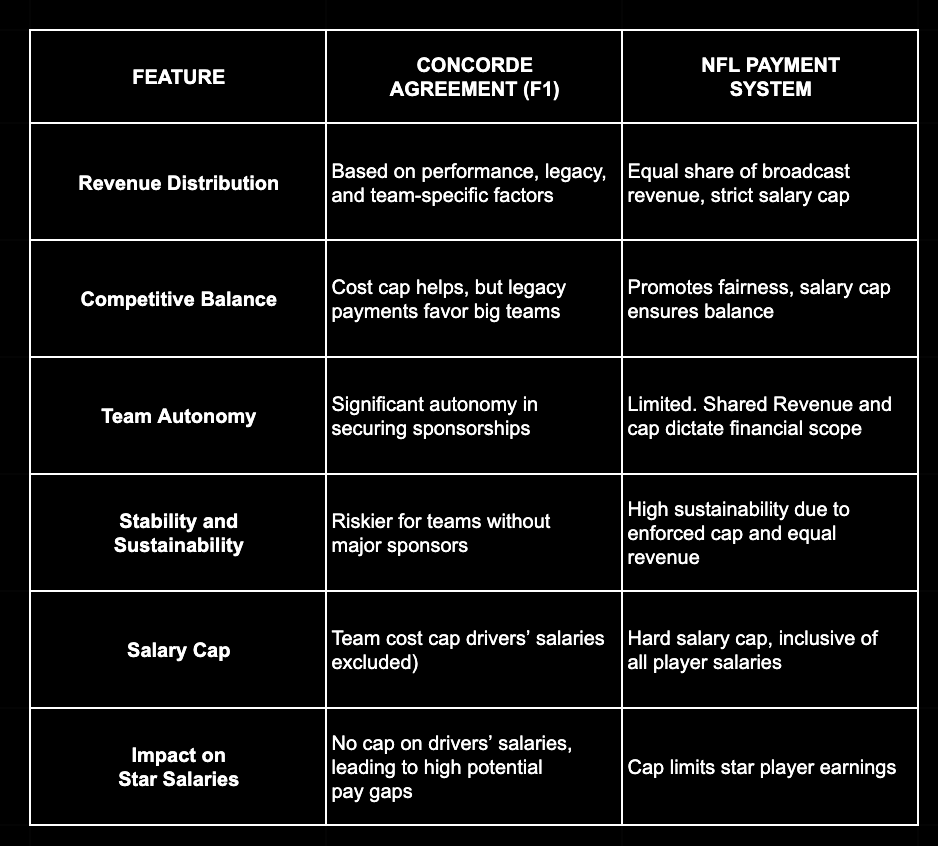Write your awesome label here.
MODULE 6
SHIFTING GEARS:
THE NFL’S SALARY
CAP SYSTEM
Lesson 16
COMPENSATION MODELS AND
CAPITAL MANAGEMENT
To better understand why Formula 1 has developed their specific financial system, it’s helpful to compare it to another large sports empire. It will help us see how each sport’s unique needs, culture, and audience shape their finances.
The NFL uses a revenue-sharing system along with a strict salary cap to keep things fair between teams. This boost reflects how the NFL bounced back financially after the pandemic and continues to grow. The revenue-sharing model between teams and players stayed steady, but the pay system still focuses on huge contracts for star players, especially quarterbacks. At the same time, teams have some wiggle room to work under the cap by restructuring contracts or offering signing bonuses. This setup lets teams adjust their payrolls without changing the overall system that spreads pay across all players on the roster.
Some league executives have talked about adding more flexibility to how teams handle salaries, especially when it comes to keeping top players while staying within budget. The current system gives team front offices a choice: spend big on star players or spread the money more evenly across the roster. Even so, the NFL remains committed to fair revenue sharing and hasn’t moved toward a fully merit-based pay system like some other leagues have considered. Instead, the NFL sticks to a structure that encourages balanced spending while still rewarding individual performance. Players can earn bonuses for hitting key stats like scoring, assists, or defensive stops, which ties their pay directly to their contributions on the field rather than just relying on guaranteed contracts.
Lesson 17
CORE FINANCIAL CONCEPTS
AND THEIR ROLE IN THE NFL
Here are some financial terms and concepts—some that we’ve talked about--and how they relate to the NFL payment system:
Revenue Sharing:
A significant portion of the NFL’s total revenue—especially from national television deals, sponsorships, and merchandise licensing—is pooled and then shared equally among all 32 teams. This system helps ensure that even teams in smaller markets, with less local income, have the financial resources to remain competitive. Revenue sharing reduces the financial gap between high-revenue and low-revenue franchises, creating a more level playing field across the league.
Salary Cap:
The NFL operates under a “hard” salary cap, which means each team is strictly limited in how much it can spend on player salaries each year. For example, in 2024, the cap was set at $225.4 million per team. Unlike in leagues with “soft” caps (which allow exceptions), NFL teams cannot exceed this limit under any circumstances. The goal is to prevent wealthier teams from simply outspending others for top talent, which supports long-term parity.
Salary Floor:
To prevent teams from cutting costs at the expense of their roster, the NFL also enforces a salary floor. This rule requires teams to spend a minimum percentage—typically around 89% of the salary cap—over a set number of years. It guarantees that owners continue investing in players rather than pocketing shared revenue, and it ensures that every team maintains a baseline level of competitiveness and roster quality.
Equal Distribution of Broadcast Revenue:
One of the strongest pillars of the NFL’s financial system is the equal distribution of its massive national broadcast revenue. TV contracts with networks like CBS, FOX, NBC, ESPN, and Amazon are negotiated at the league level and divided evenly among all teams. This means that regardless of team performance or market size, each franchise receives the same amount from national broadcasting deals—usually amounting to hundreds of millions of dollars per year. This consistent income gives every team a stable financial foundation, independent of local ticket sales or media markets.
Lesson 18
ADVANTAGES OF THE NFL
REVENUE-SHARING MODEL
There are some major benefits to this model:
Competitive Balance: The salary cap and equal revenue sharing promote fairness and make sure that eleven smaller teams can remain competitive.
Financial Sustainability: The cap system prevents teams from overspending on player salaries, promoting long-term financial health across the league.
Player Security: Minimum salary floors require teams to spend a fair amount on players, so that even bench players receive competitive pay.
Lesson 19
VISUAL COMPARISON OF
F1 AND NFL FINANCIAL SYSTEMS
Now let’s look at this chart and compare the two different financial structures of F1 and the NFL:


